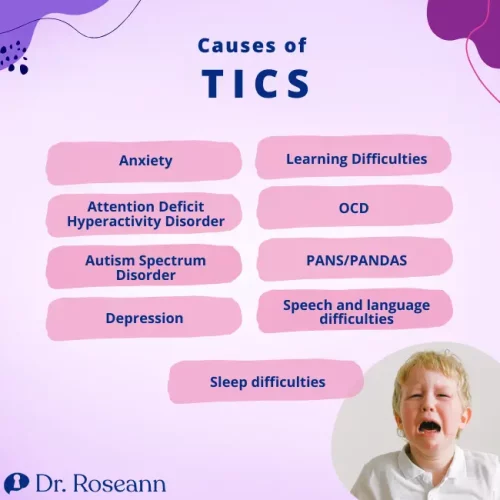Estimated reading time: 7 minutes
One day your child is fine. The next, they're blinking nonstop, clearing their throat, or making strange noises and you have no idea why. It’s scary and confusing, especially when it comes with anxiety, meltdowns, or obsessive behavior that weren’t there before.
What you’re seeing might not just be random or behavioral—it could be a sign of PANDAS, a mental health condition where an infection triggers inflammation in the brain. Tics, along with sudden emotional and behavioral changes, are some of the hallmark symptoms.
What are PANS and PANDAS in Children?
PANS (Pediatric Acute-onset Neuropsychiatric Syndrome) and PANDAS (Pediatric Autoimmune Neuropsychiatric Disorders Associated with Streptococcal infections) are autoimmune conditions where an infection, toxin, or inflammation triggers a misdirected immune response in the brain.
When this happens, children can suddenly develop symptoms like:
- Obsessive thoughts or compulsive behaviors (OCD)
- Severe separation anxiety or mood swings
- Sudden loss of academic or handwriting abilities
- Tics (motor or vocal)
- Food restrictions, rage episodes, or urinary issues
Can PANS or PANDAS Cause Tics?
Yes, and for many families, tics are one of the first red flags that something’s off. They often show up out of nowhere… blinking, throat clearing, facial movements, sometimes overnight.
They’re a sign of inflammation in the brain. The body’s immune system reacts to something it sees as a threat, like strep or another infection.
What makes these tics different:
- Appear abruptly, often after an illness
- May wax and wane, especially after stress or infection
- Often paired with OCD, rage, or anxiety
- Not typically present before age 3 but can show up suddenly anytime after

What Do PANDAS Tics Look Like?
PANDAS related tics can include both motor (movement-based) and vocal (sound-based) symptoms.
| Motor tics | Vocal tics |
|---|---|
| Eye blinking | Throat clearing |
| Facial grimacing | Sniffing |
| Shoulder shrugging | Humming |
| Head jerking | Grunting or squealing |
How Do You Tell the Difference Between PANDAS Tics and Tourette's?
It’s a question I get all the time: Is this Tourette's or PANDAS?
While both involve tics, there are key differences:
| Feature | Tourette’s | PANDAS/PANS |
|---|---|---|
| Onset | Gradual, over time | Sudden, overnight |
| Other Symptoms | Primarily tics | Tics + OCD, rage, anxiety, regressions |
| Trigger | Neurological / developmental | Autoimmune / inflammatory |
| Age of Onset | Often early childhood | Usually 4–12, post-illness |
What Triggers a PANS/PANDAS Flare?
Flare-ups often happen after:
- Strep infection (Group A beta-hemolytic)
- Viral infections (flu, COVID, etc.)
- Lyme disease or co-infections
- Mold, parasites, or mycotoxins
- Environmental toxins (heavy metals, pesticides)
- High emotional or physical stress
A flare means your child’s immune system has gone back on the attack, this time, targeting the brain again. That’s why symptoms can pop up suddenly or get worse without warning. One day things feel manageable, the next… everything shifts.
Parent Tip: “Let’s calm the brain first. When we reduce inflammation and support detox pathways, kids can get back to themselves.”
Can PANDAS/PANS Tics Go Away?
With the right treatment and nervous system support, these tics can improve or even fully resolve.
That means calming the immune system, supporting the gut-brain connection, and using brain-based interventions like:
- Targeted supplements (magnesium, omega-3s, anti-inflammatories)
- Neurofeedback to improve brain regulation
- PEMF (Pulsed Electromagnetic Field) therapy to calm the nervous system
- Anti-inflammatory diet (gluten/dairy-free)
- Natural antimicrobials when needed
Henry’s parents were told to “wait it out” after his tics began. But they knew something wasn’t right. Once they ran a brain map and found inflammation, they began neurofeedback and nutritional therapy. Within 3 months, Henry was sleeping better and his tics were 90% gone.
Tired of feeling like no one gets it?
The Natural PANS / PANDAS Calm Brain Kit gives you the science-backed tools and steps I use in my clinic to help calm tics, OCD, rage, and more.
How to Help Your Child with PANDAS Symptoms and Tics
1. Treat the Underlying Cause
- Antibiotics: Antibiotic treatment is commonly used to treat PANDAS by addressing the lingering strep infection.
- Anti-inflammatory Therapies: To reduce brain inflammation and restore balance.
2. Support Movement and Motor Control
- Occupational Therapy: Helps rebuild fine motor skills and overcome dysgraphia.
- Physical Therapy: Improves gross motor coordination and helps with hyperactivity or akathisia.
- Cognitive Behavioral Therapy: CBT can help manage tics by teaching children strategies to recognize triggers, reduce stress, and develop alternative responses to suppress or redirect tic behaviors.
3. Calm the Brain with Neurofeedback and PEMF
- Neurofeedback and PEMF Therapy: Non-invasive tools that regulate brain activity and reduce inflammation, calming your child’s overactive nervous system.
4. Create a Supportive Environment
- Establish routines that provide structure and reduce unpredictability.
- Offer calm reassurance during flare-ups, helping your child feel safe while they navigate the storm.
When your child is struggling with tics and movement issues, it’s easy to feel helpless or overwhelmed. But let’s be clear: your child isn’t being difficult, and you didn’t cause this. PANDAS is a medical condition, not a reflection of your parenting.
Can Heavy Metal Toxicity Cause Tics?
Yes. Heavy metals like lead, mercury, and aluminum can disrupt the nervous system and trigger tics, especially in sensitive children or those with poor detox pathways.
These toxins may:
- Increase brain inflammation
- Disrupt neurotransmitters (dopamine, serotonin)
- Impair mitochondrial function
You can support detox through:
- Binders (chlorella, zeolite)
- Epsom salt baths
- Liver support (milk thistle, dandelion)
- Clean water, air filters, and organic foods
If your child has developed tics out of nowhere—and especially if other issues like OCD or rage came along with them—don’t ignore your gut feeling.
PANDAS and tics are real. And the sooner you address the root cause, the better your child’s chances of recovery.
Parent Action Steps
Frequently Asked Questions
What is the first step if I suspect PANDAS?
Start with your pediatrician, but find a PANS/PANDAS-literate provider. Testing for strep, Lyme, and inflammatory markers can help confirm.
Are tics always related to PANDAS?
No, some tics are developmental or neurological (like Tourette’s), but sudden-onset tics with behavioral changes should be investigated.
Can my child outgrow PANDAS?
Some kids do improve with time and treatment. But many need ongoing immune and nervous system support to maintain regulation.
Is there a brain test that can help?
Yes—a QEEG brain map can show areas of dysregulation, which helps guide targeted treatments like neurofeedback.
Citations
Swedo, S. E., Leonard, H. L., Garvey, M., Mittleman, B., Allen, A. J., Perlmutter, S. J., … & Rapoport, J. L. (1998). Pediatric autoimmune neuropsychiatric disorders associated with streptococcal infections: Clinical description of the first 50 cases. American Journal of Psychiatry, 155(2), 264–271. https://doi.org/10.1176/ajp.155.2.264
Song, E. (2021). Understanding neuroinflammation in kids: How PANS and PANDAS affect the body and brain. Healthy Kids Happy Kids Blog. https://healthykidshappykids.com/2021/06/16/pans-and-pandas/
Capanna-Hodge, R. (2023). The BrainBehaviorReset™ approach: Rethinking behavior through the lens of nervous system regulation. It’s Gonna Be OK! Podcast, Episode 141. https://drroseann.com/podcast/
Dr. Roseann Capanna-Hodge is a licensed mental health expert that is frequently cited in the media:
- The Mac Talks: Fighting the Stigma on Mental Health & Lyme Disease
- Learning to Slay the Beasts Podcast: Treating PANDAS, PANS and Lyme
- Clearly Clinical Podcast: What you need to know about PANS/PANDAS
Always remember… “Calm Brain, Happy Family™”
Disclaimer: This article is not intended to give health advice and it is recommended to consult with a physician before beginning any new wellness regime. *The effectiveness of diagnosis and treatment vary by patient and condition. Dr. Roseann Capanna-Hodge, LLC does not guarantee certain results.
Are you looking for SOLUTIONS for your struggling child or teen?
Dr. Roseann and her team are all about science-backed solutions, so you are in the right place!
Are you looking for solutions to help your child cope with PANS/PANDAS? Check out Dr. Roseann’s Therapist-Approved Coping Skills









